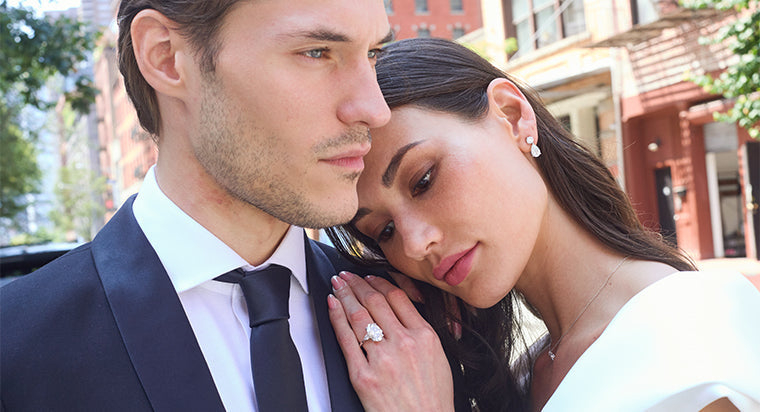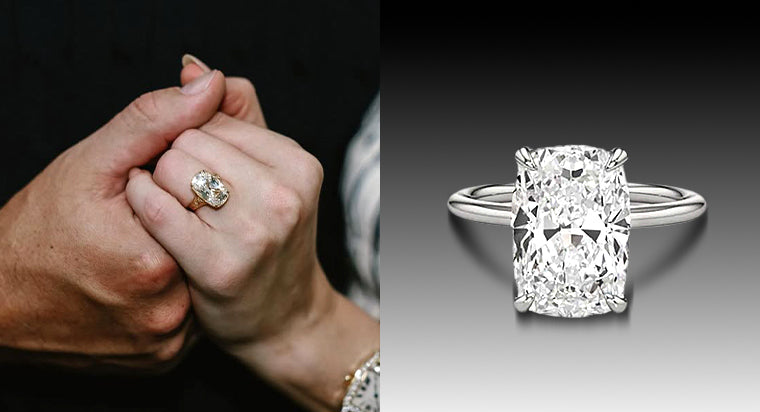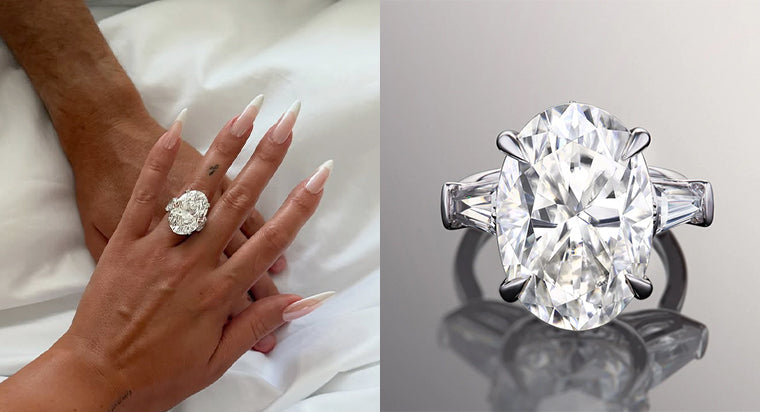Round Cut Diamond Engagement Rings - Guide to Finding the Perfect Sparkle

Nothing sparkles quite like a round brilliant cut diamond. Its 57 or 58 facets catch and reflect the light for a fantastic engagement ring. It's not surprising that the round-cut diamond is the most popular cut - it's a timeless, versatile, and gorgeous addition to an engagement ring. Let's explore all there is to know about round cut diamond engagement rings.
Understanding Round Cut Diamonds
There's a lot that goes into making a diamond sparkle. Here are the components that impact a diamond's complex cut:
- Culet: The diamond's bottom tip.
- Pavilion: The diamond's bottom half.
- Girdle: This refers to the part of a diamond that separates the crown (top) from the pavilion (bottom).
- Crown: This is the upper section that is typically the most visible part of the gemstone because it faces upwards towards the wearer.
- Depth: The diamond's depth is its height (in millimeters) measured from the culet (bottom tip) to the table (flat, top surface).
- Table: This refers to the diamond's flat facet, which can be seen when the stone is faced up. It's the largest facet, so the table plays a vital role in creating the diamond's brilliance.
Every diamond is unique, so take a close look at the cut of any diamond you're considering in terms of the 4Cs (carat, cut, clarity, and color). Cut is important for round diamonds because it impacts the amount of fire and scintillation you'll see and is the ring's focal point. A classic solitaire keeps all the attention on the center stone, and this solitaire variation is another sleek option.
The History and Popularity
Where did the round-cut engagement ring come from? Archduke Maximillian of Austria, in 1477, commissioned the first documented diamond engagement ring for his betrothed, Mary of Burgundy, according to the American Gem Society. The Archduke started a trend for diamond rings among European aristocracy and nobility. During the Renaissance period, diamond engagement rings became more popular, and the designs became more creative. Settings featured more elaborate and ornate designs as well as multiple stones.
Round cuts are a popular diamond choice because they showcase the stone's brilliance and fire. They're also very durable because they don't have corners or points. Many are drawn to the classic elegance of a round diamond - some are simple solitaires, while others have intricate details to enhance the center stone.
Choosing the Perfect Ring
It's important to have an estimated budget in mind before you begin shopping for rings. This can help narrow down your options and enable you to find the right size and quality of diamond within your budget range. If you're looking for a larger diamond but have a limited budget, you can opt for a lab grown diamond. These diamonds are cost-effective but offer the same sparkle and shine as natural diamonds, with the added benefits of being ethically sourced and environmentally friendly.
Once you decide on a round diamond, there are several other options you can choose from. You will see a variety of setting styles, such as solitaire, halo, pavé, and bezel set. It's important to check out each setting type to see how different they look. In addition to the setting, the metal type also impacts the overall appearance of the ring, as well as your budget. The most common metal types are platinum, white gold, yellow gold, and rose gold.
You can also check out With Clarity's Home Preview option, where you pick out and customize two round-cut rings of your choice and get them shipped to you. They're replica rings that look just like the real thing, allowing you to admire and wear the engagement rings you've selected and shortlist the ones you absolutely love. It's a great way to see it on your hands before completely committing.
Ethical Sourcing and Certification
Certified diamonds will tell you if the diamond is verified as being either 100% natural or lab grown and that the quality of the diamond (color, clarity, and often cut) meets a certain standard, according to a qualified, experienced gemologist. Well-known organizations that grade diamonds include Gemological Institute of America (GIA) and International Gemological Institute (IGI).
Lab grown diamonds have many benefits over mined diamonds. One significant benefit is that they are conflict-free and have a sustainable sourcing process. Unlike mined diamonds, lab grown diamonds are not extracted from the earth, making them conflict-free. Additionally, creating lab grown diamonds requires using fewer natural resources than mining, which is resource-intensive. Furthermore, these diamonds are more affordable and you can find a wide range of round cut diamonds to choose from.
Caring for Round Cut Diamond Rings
To maintain the shine and brilliance of your diamond, it's important to clean it periodically and remove any dirt or grime buildup. You can easily do this at home by soaking it in a bowl of warm water for a few minutes and gently brushing off any stuck-on grime using a soft brush. Additionally, it's vital to ensure your diamond remains safe and secure, so you should have it inspected periodically by a professional jeweler. During the inspection, the jeweler will examine the stone, prongs, and other components to ensure everything looks good and identify any potential issues that need to be addressed.
Budgeting and Cost Considerations
Budget is a big part of picking an engagement ring, but you do have some choices here as well. If you're looking for a budget-friendly option, lab grown diamonds are the way to go. In addition to allowing you to get a larger diamond for less money, they're sustainable and ethically sourced stones. With Clarity offers plenty of round-cut lab grown engagement ring options so you can find the perfect diamond for your ring well within your budget. Their expert gemologists are always happy to answer any questions along the way.
Another aspect of your engagement ring budget is the diamond's quality. A higher-quality diamond will impact the cost, and natural diamonds will always cost more than lab grown diamonds. Remember that larger diamonds will cost more, too - especially natural large diamonds because they're rare.
Personalization and Trends
Modern couples want an engagement ring that's unique to them, leading to the emergence and growing popularity of engraved engagement rings. You can engrave something personal on the inside of the band of your round-cut engagement ring for a meaningful touch. At With Clarity, you can engrave your rings for free. With an array of ring options, you can find the setting of your dreams and customize them to make them even more unique. You can also find personal touches, such as a tiny blue sapphire on the setting or a hidden halo. Making a ring personal always adds a special touch.
Conclusion
Round engagement rings continue to remain popular due to the unbeatable brilliance, scintillation, and fire that they offer. Additionally, round diamonds are versatile, providing plenty of options for settings. You can easily find a setting you like and customize the metal, size of the center stone, and any personal touches to create a unique ring. With Clarity, you can make the perfect ring that fits your taste and budget without breaking the bank.









